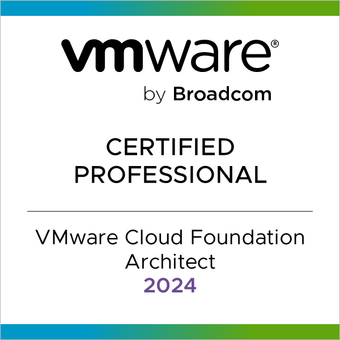My VCP VCF Architect Exam Experience

Yesterday evening, I took the VCP VCF Architect Exam and passed!
While the experience is still fresh in my mind, I wanted to share my insights to help you prepare for this exam.
Exam Preparation Tips
Scheduling the Exam
When booking the exam, choose a timeslot free from distractions. I made the mistake of scheduling it slightly after my son’s usual bedtime, assuming he would be asleep. Unfortunately, he was not, and his cry for daddy made it difficult to concentrate on the heavy and demanding exam questions. Kudos to my wife for dealing with him.
Study Materials
Here are the materials I used to prepare:
- Exam Study Guide
- VCF 5.2 Design Guide
- VMware Validated Solutions
- Breaking down the conceptual design, RCARs and AMPRS …. VCDX style
Exam Study Guide
It’s crucial to thoroughly review the exam study guide as it outlines the topics and types of questions you will encounter. This advice applies to all exams! Go through each line item, make notes if necessary, and focus on areas where you feel less confident. Remember, this is an architecture exam, so questions will revolve around architecture design, components, and design decisions. The Broadcom documentation is excellent, and if you have experience with VCF designs, you should recall how it all fits together.
VCF 5.2 Design Guide
Skim through the sections to understand the prerequisites, types, and topologies that comprise VCF. There is no single way to design it; the customer’s requirements and constraints will determine the VCF topology for your design.
VMware Validated Solutions
This resource includes design guides for the Aria Suite. You don’t need to delve into every detail, but understanding the architecture, components, sizing, and networking is essential for creating a design.
Breaking down the conceptual design, RCARs, and AMPRS – VCDX style
Jeffrey Kusters' blog is an invaluable resource that I relied on during my VMware VCAP Design exams. It significantly helped me understand the typical architectural definitions encountered in day-to-day consulting design engagements. I highly recommend reading it, as there will be plenty of questions based on these terminologies.
Areas to Focus On
According to the Exam Study Guide, expect many scenario-based questions that require concentration. Like any customer engagement, you’ll face various requirements and constraints. The questions often list several details, and the challenge is to identify what is relevant and answer accordingly. Focus on what is best for the customer, not necessarily what you think is the best design.
You need to understand and differentiate the following, as many questions will cover these areas:
- Business Requirements
- Technical Requirements
- Functional Requirements
- Non-Functional Requirements
- Constraints
- Assumptions
- Risks
- AMPRS (Availability, Manageability, Performance, Recoverability, Security)
- RPO/RTO
- Conceptual, Logical, and Physical designs
The VCF 5.2 Design Guide is essential for understanding different design requirements and recommendations for:
- Standard architecture
- Consolidated architecture
- VCF Instances
- Availability Zones
- Workload Domains (Standard and Isolated)
- Sizing
- Physical Networking requirements
- NSX
- Aria Lifecycle
- Application Virtual Networks (AVNs)
- ESXi / vSphere Clusters
If you haven’t read the design guide, make sure you do! This exam focuses on architecture, so your knowledge will be tested.
There were many questions on Aria (I assume we can blame our friend Simon Eady for that), same principal as above, hence me providing the VMware Validation Solutions Link.
There were some questions on HCX, Kubernetes, very light touch (well for me), as long as you know what their intended purpose is for, that should help you answer the questions.
Final Thoughts
Overall, it’s a fun and interesting exam. I enjoy scenario-based questions as they engage your problem-solving skills more than questions that can be easily googled.
Feel free to reach out to me for guidance or help with your study. Good luck!

